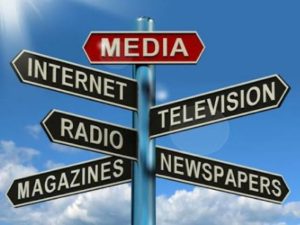Relevance: Essay and Sociology:
Social Change in Modern Society:
-
Sociological theories of social change.
-
Development and dependency.
-
Agents of social change.
-
Education and social change.
-
Science, technology and social change.

Introduction:
The term „Social Change‟ is used to indicate the changes that take place in human interactions and interrelations. Any change that alters basically the established form of social relationships, thus transforming in some measure, the social structure, is social change. It includes alterations in the structure and functions of the society.
Mass media is a term used for dissemination of information, ideas and entertainment by uses of technological media such as radio and television, cinema, press and advertising.
They continue to coexist with important traditional media such as folk song and dance, drama, puppetry, etc. These all are referred to as mass media, because it communicates to a mass audience comprised of very large numbers of people.
Mass media has bring a process of digital revolution, in which a society prior to its traditional form of communication mode, changes rapidly in various forms and modes like socio-cultural, psychological, economic, political, etc.
It is an agent of social change. Mass media has been introduced in India through the process of westernization. Mass media is a device that can spread the requisite knowledge and attitudes quickly and widely.
Even David Lerner calls the mass media as “mobile multiplier”. Canadian media theorist Marshall McLuhan (1964) argued that different types of media have different effects on society. His famous dictum is “the medium is the message”.
A society is influenced much more by type of media than by content or messages which are conveyed by it. He further says that the electronic media tends to create a global village in which people throughout the world see major events unfold and hence participate in them together. We have been witnessing a process of convergence in production, distribution, consumption, etc. of information.
Newspapers can be read online, mobile phones use is exploding, and digital television with satellite broadcasting services allow an unprecedented diversity of choice for viewing audiences. With expansion of technologies such as voice recognition, broadband transmission, web casting and cable links, the internet threatens to erase distinction with traditional media and to become primary conduct for delivery of information, entertainment, advertising and commerce to media audiences.
Some recent changes in the mass media can be highlighted like:
- Development of interactive or social media
- Digitalization of data
- Satellite communications
- Online services, chat rooms, software libraries, electronic bulletin boards, etc.
- Constant improvement in capabilities of computers with declining costs
- Use of fiber optics
Functions of mass media
- Information:
The media provides us with a continuous flow of information about our society and the world, from webcams and radio reports alerting us to traffic jams, to rolling weather reports, the stock market and new stories about issues that might affect us personally.
- Correlation: The media explains and helps us to understand the meaning of the information it gives us. In this way the media provides support for established social norms and has an important role in the socialization of children, providing a shared framework for the interpretation of events.
- Continuity: The media has a certain function in expressing the dominant culture, recognizing new social developments and forging common values. It acts as the mirror and watchdog of society.
- Entertainment: The media provides amusement, a diversion from the rigors of work and acts to reduce social tensions. This is essentially the function of a release valve for society, allowing people to set aside their problems and conflicts, at least temporarily.
- Mobilization: The media can be used to encourage people to contribute to economic development, to support and uphold moral rules and to mobilize the population in times of war. This can be through very direct public campaigns, but also in much more subtle ways, such as the moral tales within soap operas or movies, for example.
Other functions:
- Newspapers and periodicals have played a tremendous role in bringing about change in the social outlook of masses. In rural India, radio and T.V. are still the most important source for public opinion and knowledge building because most of rural sections are still illiterate.
- Films are other effective audio-visual medium of entertainment and dissemination of ideas. It also has promoted change in dressing pattern, hairstyle, spoken language, mannerism and social norms. Programmes targeting youth and women empowerment have also been promoting social change.
- Cinema has tackled current social problems like untouchability, drug addiction, AIDS, tribal identity, etc. In order to educate the masses the film division has produced documentaries dealing with health, hygiene, farming, environment, illiteracy and other subjects and screened it throughout the country. It has make people aware about their rights and duties through programmes like Atulya Bharat, Satyameva Jayte, Polio Eradication campaigns, etc.
- It has also broadened the area of education by linking it with World Wide Web. EDUSAT satellite is the modern form of coverage. Student through smart classrooms can communicate with the world. Medical facilities have become standard through telecommunications.
- E-commerce and E-shopping are the new faces of economy. Money is now stored and travelled in electronic form. Online shops like Flipkart, Amazon, etc. have transformed a person into a buyer and a seller both.
- It has transformed the kids into smart tech bros where the can connect with world history, animal world and planets, scientific discoveries, etc. Dysfunctions
- The Frankfurt school saw modern mass media as part of the culture industry which threatened to stifle creativity and reduces the quality of cultural products. Especially with the effect of consumer culture industry, the local languages and their indigenous part is getting ruined. For e.g. The vulgarization of Bhojpuri through popular songs.
- Because of monopoly of big corporate agencies and MNCs, which are holding the news channels, the quality and authenticity of the news is getting affected. For e.g. the heavy cost of sacrificing social issues for the sake of paid news.
- T.V. channels for the sake of T.R.P. (television rating point) are producing fake and sometimes superstitious believes which creates sensation in the mindset. For e.g. one hour episodes on daily horoscopes, chamatkari baba, ghost, gods and goddesses, etc.
- Jean Baudrillard argues that the news media, particularly television, creates a new hyperreality which comprises both the real world and its representations. Thompson argues that mass media have created a new form of social interaction, i.e. mediated quasi-interaction, that is more limited, narrow and one way than everyday social interaction. For e.g. addiction of messaging and chat through Facebook and Watsapp sometimes by creating fake id accounts.
- Newspapers particularly the tabloid press, have become less focused on providing news and more oriented towards reporting, creating and sustaining modern celebrity culture through huge coverage of page three parties, affairs, gossiping, etc.
- Cyber-crimes and hatred nationalism can be easily communicated through mass media and with the help of fake viral videos.
- Too much T.V. viewing can act as a drug and can create physical and mental problems like disordered personality and sometimes cases of hallucinations are related with too much attachment with idiot box.
- Internet has also opened the gate for porn industry, online sex, stalking, etc. · Cyber world sometimes promote fake identities with the result of which, real identity and world get sidelined.
- Crime related T.V. serials, movies, etc. can create attraction towards the crime and mafia world. For e.g. the famous Virginia Tech University case, imitation of stunt of W.W.F. by children at home which causes accident, etc.
Relations are getting more commercial, cyber, fake, practical, etc. because of this effect of mass media. For e.g. serials like Emotional Atayachar, How to steal your girlfriend, Splits villa, etc. create condition of cheating and deception with partners. Mass media is a double edged weapon. It has pros and cons. It depends on the rational outlook of masses how to use it for the betterment of society.

